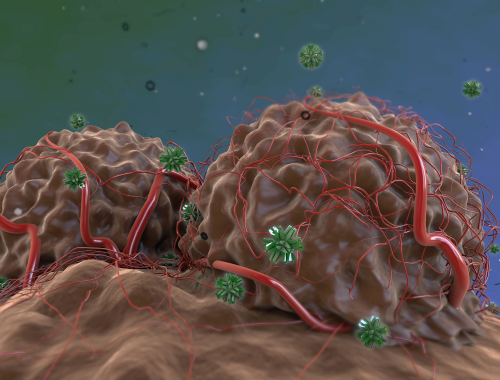Difference Between Cancerous Tumors and Noncancerous Tumors
Cancerous tumors, also known as malignant tumors, are an abnormal collection of cells that are rapidly enlarging and can spread to other parts of the body. Noncancerous tumors or benign tumors are an abnormal collection of cells, which grow very slowly, do not spread to other body parts, and are not harmful in general.

What are cancerous tumors?
Definition:
Cancerous tumors, also known as malignant tumors, are an abnormal collection of cells that are rapidly enlarging and can spread to other parts of the body.
Structure:
Cancerous tumors have irregular margins and an uneven shape. They are immobile and adherent to the underlying tissue.
Invasion and metastasis:
Cancerous tumors are rapidly spreading and tend to invade nearby tissues readily. Malignant tumors are more likely to spread to other organs.
Recurrence:
Malignant tumors have a higher propensity to recur after being removed.
Examples:
Examples of cancerous tumors include carcinomas such as adenocarcinoma, basal cell carcinoma, sarcomas, germ cell tumors, and blastomas.
Treatment:
Treatment options for malignant tumors include surgery, chemotherapy, radiotherapy, and immunotherapy.

What are noncancerous tumors?
Definition:
Noncancerous tumors or benign tumors are an abnormal collection of cells, which grow very slowly, do not spread to other body parts, and are not harmful in general.
Structure:
Noncancerous tumors have a smooth, regular shape. They often move around while applying pressure.
Invasion and metastasis:
Noncancerous tumors do not invade adjacent structures and do not tend to spread to other parts of the body.
Recurrence:
Once removed, noncancerous tumors do not return.
Examples:
Examples of noncancerous tumors include adenomas or polyps, fibroids, hemangiomas, and lipomas.
Treatment:
Most benign tumors do not require excision, however, if they start to increase in size, surgery might be needed to remove the mass.
Difference between Cancerous tumors and Noncancerous tumors
Definition:
Cancerous tumors, also known as malignant tumors, are an abnormal collection of cells that are rapidly enlarging and can spread to other parts of the body. Noncancerous tumors or benign tumors are an abnormal collection of cells, which grow very slowly, do not spread to other body parts, and are not harmful in general.
Structure:
Cancerous tumors have irregular margins and an uneven shape. They are immobile and adherent to the underlying tissue. Noncancerous tumors have a smooth, regular shape. They often move around while applying pressure.
Invasion and metastasis:
Cancerous tumors are rapidly spreading and tend to invade nearby tissues readily. Malignant tumors are more likely to spread to other organs. Noncancerous tumors do not invade adjacent structures and do not tend to spread to other parts of the body.
Recurrence:
Malignant tumors have a higher propensity to recur after being removed whereas once removed, noncancerous tumors do not return.
Examples:
Examples of cancerous tumors include carcinomas such as adenocarcinoma, basal cell carcinoma, sarcomas, germ cell tumors, and blastomas. Examples of noncancerous tumors include adenomas or polyps, fibroids, hemangiomas, and lipomas.
Treatment:
Treatment options for malignant tumors include surgery, chemotherapy, radiotherapy, and immunotherapy. On the other hand, most benign tumors do not require excision, however, if they start to increase in size, surgery might be needed to remove the mass.
Table of differences between Cancerous tumors and Noncancerous tumors

FAQs
Can noncancerous tumors become cancerous over time?
Yes, noncancerous tumors can become cancerous over time. For example, colonic polyps have the tendency to become malignant therefore they should be surgically excised.
Are cancerous tumors or noncancerous tumors more common?
Noncancerous tumors are more common than cancerous tumors.
What is the prognosis for cancerous tumors and noncancerous tumors?
Cancerous tumors have a poor prognosis whereas noncancerous tumors have a good prognosis.
How are cancerous tumors and noncancerous tumors treated differently?
Noncancerous tumors may be left in place if they do not invade the adjacent structures. If enlarging in size, these benign tumors might be surgically excised. The treatment of noncancerous tumors includes surgery, radiotherapy, chemotherapy and immunotherapy.
Can cancerous tumors or noncancerous tumors be prevented?
No, however a healthy lifestyle can help reduce the risk of getting cancer.
- Differences Between Reptiles and Amphibians - May 17, 2024
- Difference Between Ophthalmology and Optometry - May 15, 2024
- Difference Between Fear and Anxiety - April 2, 2024
Search DifferenceBetween.net :
Leave a Response
References :
[0]Patel, Aisha. "Benign vs malignant tumors." JAMA oncology 6.9 (2020): 1488-1488.
[1]Warburg, Otto. "On the origin of cancer cells." Science 123.3191 (1956): 309-314.
[2]Rahbar, Guita, et al. "Benign versus malignant solid breast masses: US differentiation." Radiology 213.3 (1999): 889-894.
